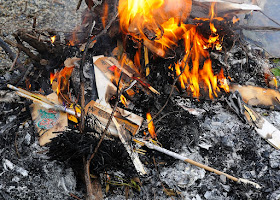
I arrived at my neighborhood Shinto shrine at 8:30 AM and was warmly greeted by the older men who had already started the fire. I chatted with them, asked questions and took several photographs. For the next two hours my senses were ablaze and abuzz: the heat of the fire and the burning sensation on my fingers as I struggled with the yaki imo (baked sweet potato); the taste of the hot sweet potato and cold beer served in a paper cup; the sound of the crackling fire especially when the dry leaves were placed upon it; the various smells of wood, leaves and plastic bags; and the sight of beautiful charms and talisman being engulfed by the flames created a sensory ethnography experienced bodily.



My neighborhood shrine, Ubusuna Jinja (産土神社) in Kadoma-shi, Osaka, conducted its Tondo Festival (とんど祭り) on January 15, to coincide with ko-shogatsu (小正月), or "small new year" - ko-shogatsu is a holdover from the time when Japan used a lunar calendar. This festival has many names (Dondo yaki - どんど焼き - is a common name but there are many others) and local variations. It seems to be a large celebration in Hiroshima and other locations across Japan. But my neighborhood version could barely be called a festival as it was practiced in a very low key manner. At the Tondo festival, shimekazari (a traditional New Years decoration hanged at the entrance to a house), omamori (good luck charms), ofuda (talisman), ema (votive tablets) as well as other religious or new year's related ornaments are burned. This is in effect a sort of recycling - these various ornaments are returned after a year or so of use and new ones are purchased. During my hatsumode to Hozanji temple in Ikoma every January, I return ofuda that I purchased the previous year in a special container and buy new ones. I have understood that these old ornaments were to be burned but I have never seen the ceremony itself at Hozanji.






In my neighborhood version, a group of older men from the community, members of the shrine's board of directors, started and tended the fire in the grounds in front of the shrine building itself. Housewives and other neighbors came one at a time or in small groups to drop off their talisman and charms to be burned. The men accepted the ornaments, (they separated the orange from the shimekazari as the near rotten fruit were to be thrown away rather than burned) and tossed them into the fire. Most people went to the shrine to offer a prayer. Some exchanged new year's greeting and stayed a few minutes to visit. It seemed for for most of the people that came it was the same as throwing out garbage. There was never a large crowd during the time of the event.






The men placed a few sweet potatoes in tin foil and then into the fire for roasting. After a half hour or so a couple of the men braved the extremely hot fire to retrieve the potatoes and they were shared by all. One of the men went around with paper cups and offered tea and later beer. The men chatted until 10:00 and then dug a hole in the ground, doused the fire and moved the still hot coals into the hole and buried them. By 10:30 one would not have known the event took place.







I was struck by the lack of religiosity. There was no Shinto priest officiating. Some say the Tondo smoke is purifying and is supposed to protect people from bad luck and illness. By I wondered if this were true when plastic bags, paper cups and cigarette butts were tossed into the fire. Rather than a grand festival, this was a community service event. The Tondo Festival, no matter what it is called or how it is practiced is another good example of Shinto and Japanese culture hardly being homogenous.
No comments:
Post a Comment